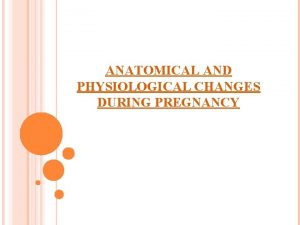Dr Madhavi Karki PREGNANCY Physiological condition of a




















- Slides: 20

Dr. Madhavi Karki

PREGNANCY Physiological condition of a woman during reproductive period (15 -45 yrs) in which development of fertilized ovum occurs in maternal body.

GENITAL ORGANS 1. VULVA 2. VAGINA • Vulva becomes edematous, swollen and hyperemic, superficial varicosities appear in multipara. • Labia minora are pigmented and hypertrophied. • Vaginal wall becomes hypertrophied , edematous and more vascular. • Increased blood supply of the venous plexus of surrounding wall, gives bluish coloration called Jackquemier’s sign. • The length of the anterior vaginal wall is increased.

SECRETION OF VAGINA- • The secretion becomes copious and thin. • It becomes more acidic to prevent multiplication of pathogenic organism. 3. UTERUS : • There is enormous growth of the uterus during pregnancy. • The weight of the non pregnant uterus is about 50 -80 gm but at term it weights about 900 -1000 gm • And the length of the uterus which is 8 cm changes to 35 cm in length. • This is due to the hypertrophy and hyperplasia in the body of the uterus.

4. CERVIX: - There is hypertrophy and hyperplasia of the elastic and connective tissue. All these changes leads to the softening of the cervix as early as 6 th week which is called Goodell’s sign. Vascularities also increases and gives rise to bluish discoloration. 5. FALLOPIAN TUBE: As the uterine end rises up and the fimbrial end is held by the infudibulo pelvic ligament it is placed almost vertical by the side of the uterus. The total length of the tube slightly increased and becomes congested.

ii. Changes in the Breast The changes of the breasts are evident in primigravida. But in multipara the changes are not so evident. SIZE: There is increase in the size of the breast. This is due to the hypertrophy and proliferation of the ducts(estrogen)and alveoli(estrogen and progesterone). Vascularity is increased and appears as veins below the skin.

NIPPLES AND AREOLA: The nipples becomes larger, erectile and deeply pigmented. Various number of sebaceous gland which was invisible in the nonpregnant stage becomes hypertrophied and is called Montgomery's tubercles. An outer zone of marked irregular pigmented area appears in second trimester which is called secondary areola. Secretion can be squeezed out from the breast at 12 th week which at first becomes sticky, watery at first and later thick and yellowish.

Chloasma or III. Cutaneous Changes A. Face: - pregnancy mask: -It is an extreme form of the pigmentation present in the cheek, forehead and around eyes. It may be patchy or diffuse and disappears spontaneously after delivery.

LINEA NIGRA: -It is brownish black pigmented area in the midline stretching from the xiphisternum to the symphysis pubis. This pigmentary changes are due to melanocytes, secretary hormone from the anterior pituitary and disappears following delivery. B. ABDOMEN: -

STRIA GRAVIDARUM : -These are slightly depressed linear marks of varying length found in pregnancy. These are found in the abdominal wall below the umbilicus, over thighs and breast. Initially these are pinkish but following the delivery these scars become contracted and becomes glistening white in appearance called stria albicans. Apart from the mechanical stretching aldosterone secretion during pregnancy is responsible for stria gravidarum.

Linea Nigra Striae Gravidarum

Other vascular changes like palmar erythema may be seen due to the high estrogen level. There may be tendency of the falling hairs and brittleness of the nail.

IV. Weight gain The total weight gain during pregnancy is 11 -15 kg i. e. 1 kg (first 12 wk), 5 kg (13 -28 wk) and 5 kg (29 -40 wk). Importance of weight checking: - Periodic and regular weight checking is important because- Rapid weight gain i. e. more than 0. 5 kg in a week and more than 2 kg a months in later months is manifestation of pre- eclampsia. Stationary falling of the weight is suggestive of IUGR or IUD.

V. Hematological changes The disproportionate increase in plasma and RBC volume produces a state of hemodilution during pregnancy Plasma Volume : Plasma Volume increases by 50% RBC mass : The RBC mass increases by 30%

White Blood Cells (WBC) – WBC count increases progressively during pregnancy with a mean value of upto 16, 000 cubic mm in the third trimester. Erythrocyte Sedimentation Rate (ESR) – ESR increases in pregnancy because of the increase in gamma globulins. Platelet Count – Platelet count normal reference range is unchanged in pregnancy. Coagulation State – Factors VII, VIII, IX and X increase progressively in pregnancy leading to a hypercoagulable state

VI. CHANGES IN CVS Due to the elevation of the diaphragm due to the enlarged uterus the heart is pushed upwards and outwards with slight rotation to the left. Abnormal clinical findings-The apex beat is shifted to the 4 th intercostal space 2. 5 cm outside mid clavicular line. Pulse rate is slightly raised.

ARTERIAL BLOOD PRESSURE – Systolic and diastolic values both decline early in the first trimester, reaching a nadir by 24 -28 weeks, then gradually rises towards the term. VENOUS BLOOD PRESSURE – Central venous pressure (CVP) is unchanged with pregnancy, but femoral venous pressure increases two to three fold by 30 weeks gestation. CARDIAC OUTPUT - Cardiac output is increased during pregnancy and starts to increase from 10 th week and reaches its peak to 40%at about 30 -32 weeks. It returns to normal level during puerperium. MURMURS - A systolic murmur may be audible in the apical or the pulmonary area.

VII. Changes in the Alimentary System STOMACH – Gastric motility decreases and emptying time increases from the progesterone effect on smooth muscle. This increase in stomach residual volume, along with upward displacement of intraabdominal contents by the gravid uterus, predisposes to aspiration pneumonia with general anesthesia at delivery. LARGE BOWEL – Colonic motility decreases and transit time increases from the progesterone effect on smooth muscle. This predisposes to increased colonic fluid absorption resulting in constipation.

VIII. Changes in the Renal System KIDNEYS – The kidneys increase in size because of the increase in renal blood flow. This hypertrophy does not reverse until 3 months postpartum. GLOMERULAR FILTRATION RATE – GFR, renal plasma flow, and creatinine clearance all increase by 50% as early as the end of first trimester. URETERS – Ureteral diameter increases owing to the progesterone effect on smooth muscle.

IX. Changes in the Endocrine System PITUITARY – pituitary size increases by 100% by term from increasing vascularity. ADRENALS – Adrenal gland size is unchanged, but production of cortisol increases two to three fold. THYROID – Thyroid size increases 15% from increased vascularity. TBG increase , resulting in increased total T 3 and T 4 although free T 3 and T 4 remain unchanged.
 Emma karki
Emma karki Pictures of spotting during pregnancy
Pictures of spotting during pregnancy Madhavi deshmukh
Madhavi deshmukh Madhavi ganapathiraju
Madhavi ganapathiraju Madhavi bhargava
Madhavi bhargava Geometric tolerance symbols
Geometric tolerance symbols Dvi aortic valve
Dvi aortic valve Elephant physiological adaptations
Elephant physiological adaptations _________ are examples of behavioral adaptations.
_________ are examples of behavioral adaptations. Physiological adaptation
Physiological adaptation Physiological significance of papez circuit
Physiological significance of papez circuit Reading as a physiological process
Reading as a physiological process Physiological factors affecting oxygenation
Physiological factors affecting oxygenation Mountain pygmy possum
Mountain pygmy possum Physiological density
Physiological density Masolow
Masolow Physiological needs according to maslow
Physiological needs according to maslow Phosphate buffer system equation
Phosphate buffer system equation Physiological disorders of strawberry
Physiological disorders of strawberry Indications of microwave diathermy
Indications of microwave diathermy Physiological design
Physiological design







































